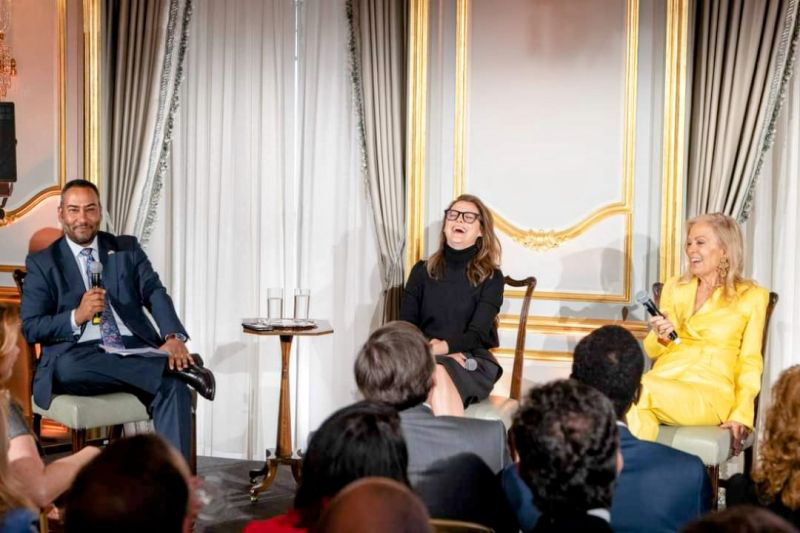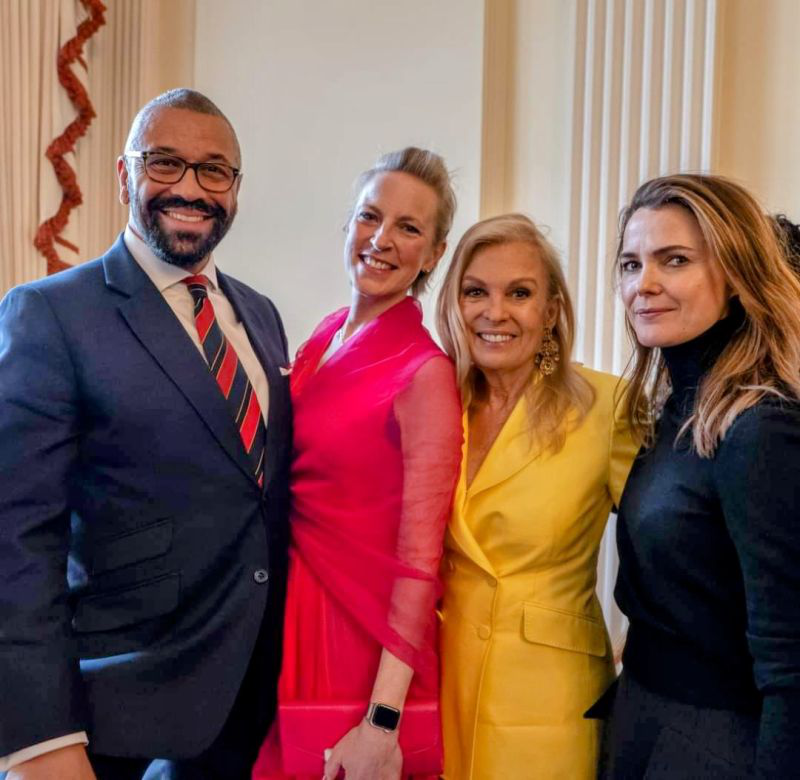Streaming Power: How Netflix and Amazon are Reshaping Global Geopolitics
Swapnil Rai / University of Michigan

After the release of the Netflix series The Diplomat, US Ambassador to the United Kingdom Jane Hartley hosted Keri Russel, the main protagonist of the Netflix show. The event included the UK Secretary of State for Foreign, Commonwealth, and Development Affairs, James Cleverly, and his wife, Susannah. The gathering was widely covered, including an article in The New York Times that noted Hartley’s background as a television executive (Lander, 2023). The mutually beneficial promotional strategy simultaneously celebrated the limelight foreign service officers deserve, explaining the nitty-gritty of the profession while promoting the show for Netflix. Within this recursive mimetic framing of life imitating art imitating life, the event was, on the one hand, used to promote the show, which allowed the Netflix team “rare access to film inside [the US Embassy’s] grand headquarters,” while Britain’s foreign secretary James Cleverly taped a video to promote the series. On the other hand, in the words of US Ambassador Hartley, the show rendered a foreign service job “as an object of fascination” (Lander, 2023). Predictably, the show was used in a recruitment post by another US Diplomat, Maryam Saifee, wherein she highlighted the “everyday heroism of diplomats” in her call to hire new personnel for the US Department of State. The power of streaming platforms—particularly Netflix and Amazon, which originate in the United States but curate global content—raises critical questions about power dynamics and its distribution across global regions.
The term soft power has provided an important framework for understanding the instrumentalization and impact of cultural flows. While soft power can signal a range of activities, from a country’s educational or corporate brand presence to the popularity of its cultural forms, such as dance or music in other regions, media soft power is slightly different. Media such as film, television, or entertainment content in current parlance need to be understood as distinctive from other forms of soft power because media possesses direct narrative-making power. While soft power itself is a “cultural-symbolic instrument of power” that is diffuse, its mobilization through media can lend it ideological import (Goddard & Nexon, 2016). In contrast to media-generated soft power, other forms of soft power that extended beyond the realm of governments to include transnational corporations were theorized by the notion of corporatism (particularly in the 80s and 90s) which centered the corporation in policy making and politics. The geopolitical dimension of it has also been a constant undercurrent; Joe Straubhaar (2021), for instance, has noted that in Brazil (and Latin America more broadly), the cultural industry and government have been articulated together via corporatism. Within more recent scholarship, digital technology has also been configured and articulated in diplomacy and understood through the impact of social media platforms on political and social affairs in foreign contexts.
All these frames are very productive; however, each speaks to only one aspect of power within the broader realm of geopolitical power. I argue that streaming mobilizes all three and that behemoth streamers like Netflix and Amazon possess a multi-modal power that includes each of these dimensions/modes of power. To articulate this multi-modal power, I want to posit the framework of Streaming Power. The first mode is corporate or brand power, and this power is constituted by how these streamers conceptualize themselves and their brand as geopolitically salient. The second mode is constituted by the platforms’ ability to create media content and thus engage in narrative storytelling that can discursively construct or shape geopolitical discourse. The third mode is platform power, which is constituted by the nature of the platform itself, which is digital and lends it a convergent, immersive (more so since the streamers are expanding to games/gaming), scalable quality. Moreover, while other forms of soft power, be it through films or products such as Coca-Cola or Apple or popular video games, have had an impact, the expanse and depth of streaming power are different because it operates in and through the multiple modes listed above and is being led by geopolitically ambitious corporate industrial actors without any clear national agendas. Therefore, it is critical to theorize and study streaming power as its unique instantiation of convergent corporate, media, and digital power that creates geopolitical influence. We can see the multiple modes of streaming power in the following examples.

Mode one: Brand Power
This power is tied to the global streamers’ self-conceptualization, which motivates their actions. To understand the implications and influence of this self-conceptualization on politics and geopolitics, we only need to take a closer look at how organizations like Netflix are connected to political actors. In 2018, right after Netflix started its concerted phase of global expansion beyond its typical markets to over 190 countries, it appointed Susan Rice, a seasoned career diplomat, to its board of directors. Rice lauded Netflix’s compelling storytelling and underscored her commitment to “contributing breadth of international and domestic experience” at a time of challenge for the entertainment industry. A few years hence, the company set up a public affairs and diplomacy office in Washington DC and appointed Clare Gallagher a former Biden-Harris National Security Council member as their public affairs and diplomacy officer. The company has since signed entertainment deals with multiple influential political celebrities such as the Obamas, Prince Harry, and Meghan Markle, positioning themselves as an influential platform that sustains the celebritization of politics (Rai 2019). Similarly, Amazon has signed deals with political figures like First Lady Melania Trump to license a documentary about her life, as well as agreements with governments—including a Creative Economy Pact with the Modi-led Indian government to globally showcase ‘made in India’ creative content and a contract with the UK government to create jobs, infrastructure, and support British brands and entertainment (Whittock, 2023). These moves point to a certain self-conceptualization of these platforms as entities exceeding the nation-state.
Mode two: Content Power
In line with their branding and conceptualization of their geopolitical significance, these global streamers create politically contentious content and utilize the politicization of content as a strategy. This strategy situates them as “potentially” influential within the realm of politics both domestically and internationally. In another essay, I examined how Netflix and Amazon strategically politicize content in India, Mexico, and Italy. Shows such as Sacred Games (Netflix), Taandav (Amazon), Narcos (Netflix), and Grillo vs. Grillo (Netflix) dramatize real political events to generate controversy. This is a small sample set of many instances of content created by these two platforms that have led to contentious legal cases or generated heated controversy or political debate. This power of content is critical because it accords the streamer’s direct narrative-making power around contemporary political and geopolitical debates. Further, the format of the streaming shows gives them more depth and space to showcase issues they choose to selectively highlight.

Mode three: Platform Power
The third mode is a foundational kind of streaming power that all streamers possess by being digital platforms with the ability to disseminate content. Furthermore, when it comes to the global circulation of digital content, many countries still do not have adequate legislative frameworks to regulate streaming (that may be slowly changing). In that sense, the platform provides streaming behemoths with the ability to circulate their content widely and, as they move forward, integrate immersive convergent strategies such as games and perhaps VR experiences into their platforms that could exponentially add to their narrative-making power and geopolitical salience. The three modes, brand, content and platform, thus culminate in a kind of streaming power that positions Netflix and Amazon as power brokers within the larger ecosystem of media and cultural diplomacy.
Image Credits:
- Series like Netflix’s The Diplomat help constitute Streaming Power
- Real world and fictional diplomats converged in May 2023
- Global streamers Netflix and Amazon have embraced politically contentious content as a promotional strategy
Fleming, Mike Jr. 2024. “Netflix, Higher Ground Partners Barack & Michelle Obama Expand Film & TV Creative Collaboration.” Deadline. June 13. https://deadline.com/2024/06/barack-michelle-obama-netflix-deal-film-tv-1235973074/.
Goddard, Stacie E, and Daniel H Nexon. 2016. “The Dynamics of Global Power Politics: A Framework for Analysis.” Journal of Global Security Studies 1 (1): 4–18.
Lander, Mark. 2023. “At the Real Embassy, Netflix’s ‘Diplomat’ Draws a Diplomatic Response.” The New York Times. May 15. Accessed September 2024. https://www.nytimes.com/2023/05/15/world/europe/netflix-diplomat-keri-russell-london.html.
Rai, Swapnil. 2019. “‘May the Force be With You’: Narendra Modi and the Celebritization of Indian Politics.” Communication, Culture & Critique 12 (3): 323-339.
Straubhaar, J. 2021. Brazil and Corporatist Soft Power. In D. K. Thussu, & K. Nordenstreng, BRICS Media: Reshaping the Global Communication Order? (pp. 159-176). London: Routledge.
Whittock, Jesse. 2023. “Amazon Signs Creative Economy Pact With Indian Government.” Deadline. April 5. https://deadline.com/2023/04/amazon-prime-video-letter-of-engagement-indian-government-ministry-of-information-and-broadcasting-1235318449/.